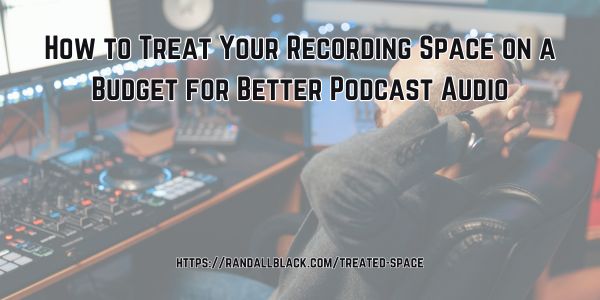Introduction
Audio quality is one of the most important aspects of a podcast. Even with engaging content, poor sound can turn listeners away. A well-treated recording space can make a significant difference, improving clarity and reducing unwanted noise. While professional studios invest in high-end acoustic treatments, amateur and hobbyist podcasters can achieve great results on a budget. In this guide, we’ll explore why acoustic treatment matters and how you can improve your recording environment without breaking the bank.
Why Acoustic Treatment is Necessary
When sound waves travel in a room, they reflect off walls, floors, and ceilings, causing unwanted echo and reverb. This makes audio sound muddy and less intelligible. Acoustic treatment helps by absorbing or diffusing these reflections, resulting in a cleaner, more professional recording.
Common Audio Issues in Untreated Spaces
- Echo and Reverb: Sound bouncing off hard surfaces creates a hollow or distant effect.
- Room Tone: Background noise that affects consistency in recordings.
- Boominess or Tinny Sound: Uneven frequency response due to sound reflections.
Improving room acoustics can help ensure that even an entry-level microphone captures clear, crisp audio.
Budget-Friendly Acoustic Treatment Solutions
Professional studios use high-quality acoustic foam, bass traps, and diffusers, but there are many budget-friendly alternatives.
DIY & Household Solutions
- Soft Furnishings: Curtains, rugs, couches, and bookshelves help absorb sound.
- Moving Blankets: Thick blankets hung on walls or across windows reduce reflections.
- Closet Recording Booth: A closet filled with clothes can serve as a makeshift recording booth.
- Mattress or Pillow Barriers: Placing a mattress or pillows behind the microphone can reduce unwanted reflections.
Affordable Acoustic Panels & Foam
- Foam Panels: Budget acoustic foam can be found online and strategically placed in your recording area.
- DIY Panels: Wooden frames filled with rockwool or insulation and covered with fabric work as effective sound absorbers.
- Where to Place Them: Focus on first reflection points (side walls, behind the mic, and ceiling if possible).
Positioning & Setup
- Carpets and Rugs: Prevent floor reflections by covering hardwood or tile floors.
- Furniture Arrangement: Bookshelves and soft furniture can act as natural sound diffusers.
- Microphone Placement: Positioning your mic properly helps minimize room noise.
Choosing the Right Microphone for Your Space
The type of microphone you use plays a significant role in how your recordings sound. Some microphones work better in untreated spaces than others.
Dynamic vs. Condenser Microphones
- Dynamic Microphones: Less sensitive to room noise, making them ideal for untreated environments.
- Condenser Microphones: Capture more detail but also pick up more room sound, best used in treated spaces.
Best Microphone Types for Different Spaces
- Cardioid Dynamic Mic: Great for noisy or untreated environments (e.g., Shure SM58, Rode PodMic).
- Supercardioid Mic: More focused pickup pattern, reducing background noise (e.g., Audio-Technica BP40).
- USB Dynamic Mic: Budget-friendly and easy to use (e.g., Samson Q2U, Audio-Technica ATR2100x).
Final Tips for Better Sound on a Budget
- Use a Pop Filter: Reduces plosive sounds (hard “P” and “B” sounds).
- Control Background Noise: Record in a quiet room, turn off noisy devices.
- Experiment and Test: Try different setups and make test recordings to find the best configuration.
- Post-Processing Tools: Use noise reduction tools in editing software if needed.
Conclusion
Improving your podcast’s audio quality doesn’t have to be expensive. Simple changes like adding soft furnishings, using DIY acoustic treatments, and choosing the right microphone can make a huge difference. Take the time to experiment with your setup, and you’ll be well on your way to producing great-sounding content without a professional studio budget.
Happy podcasting!
